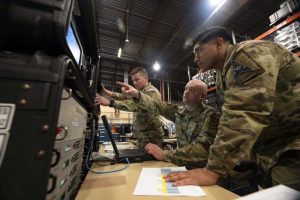Generative AI Predictions for the Defense Market
By John Reardon, Editor-in-Chief, COTS Journal

The Western world has witnessed the emergence of numerous companies backed by an eager investment community, ready to make their mark in this dynamic and growing market. With superfunds, many exceeding billions of dollars, and a drive to develop breakthrough technologies, the market is burgeoning with possibilities.
Large Language Models (LLMs) and Data Utilization
Commercial markets have focused on using Large Language Models (LLMs) to handle simple tasks by analyzing vast amounts of open-source data. While these models can answer questions and predict text, they often tolerate errors in precision. However, this tolerance may not be acceptable in the defense sector.
Power Consumption and Heat Dissipation
High-power GPUs, such as those from Nvidia, require significant energy, posing challenges in remote military operations. With modern GPUs consuming up to 700 watts, power and heat dissipation become critical issues. The commercial sector’s high energy consumption has led Nvidia to predict potential strain on the US power grid.
To address heat generation, companies are exploring advanced cooling techniques, including single and two-phase cooling methods, exotic dielectric fluids, and heat pumps. One lab innovation involves a system monitoring solution that modulates the GPU’s clock speed, reducing heat by 40% but at the cost of overall system performance.
Nuclear Power
The defense sector, with its high energy demands, continues to explore small modular reactors for propulsion and sustainable energy. Companies like Helion, backed by Sam Altman with over $500 million in initial funding, are advancing fusion technology for high-energy output in compact forms. These advancements could lead to future replacements for conventional propulsion systems in the Navy.
Data Quality
The effectiveness of LLMs and machine learning tools depends on high-quality data. Relying on suspect open-source data can lead to diminishing returns and potential collapse due to data “inbreeding.” The rapid adoption of AI across consumer platforms exacerbates this issue. As primary sources challenge copyright laws and shift marketing dollars away from data-scraping companies, the trend towards synthetic data is likely to continue.

Chip Shortage
The shortage of Nvidia’s H100 GPUs is well-known, with TSMC’s CoWoS technology unable to meet demand. Secondary markets have emerged, supporting high markups for those willing to pay. However, production levels are gradually catching up.
Nvidia faces competition from its largest customers, including Google and Amazon, who are developing their own solutions. Intel and AMD remain strong contenders, with Intel partnering with Nvidia to address TSMC production shortfalls.
Security Concerns
Confidential data breaches and data poisoning are growing concerns, particularly in the defense sector. The possibility of a wearable solution with data center performance creating an open link to enemies raises significant security fears. Exposed battle plans and technologies could be exploited by adversaries.
The fragmented Machine Learning Operations (MLOps) market sees the defense sector favoring single-source solutions, as evidenced by Amazon’s market share gains. Analysts predict valuation declines and consolidation similar to the cybersecurity market trends related to consumer devices.
Multimodal AI
Developing tools that extract information from various sources and combine data from different modalities is promising for military solutions. Multimodal AI can integrate images, videos, and text, enhancing data validation and coordination. In medical applications, this could improve battlefield casualty survival rates. As complexity increases, multimodal AI solutions become invaluable, handling numerous variables that exceed human capacity.
Advances in AI Applications

While commercial AI discussions often focus on dating apps, entertainment, and deep fakes, these seemingly trivial applications drive significant technological advancements. The ability to create deep fakes or identify targets in complex environments parallels military needs, showcasing the broader impact of commercial AI innovations.
Conclusion
The defense market stands at the brink of significant transformation through generative AI. As the sector grapples with power consumption, data quality, security, and technological advancements, the integration of AI promises to reshape military operations and strategies, driving both innovation and complexity.

